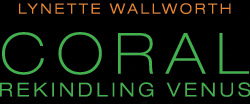RESEARCH
Lynette Wallworth’s work is greatly influenced by the Great Barrier Reef on Australia’s Eastern Coast. She experienced the astounding once yearly mass spawning event on the GBR with marine biologists and underwater cinematographer David Hannan in 2000 as part of the development of her first work to feature the GBR, HOLD Vessel 1 in 2001. The Great Barrier Reef is the world’s largest reef.
Reef colonies are made by tiny animals – coral polyps who live in a symbiotic relationship with microscopic algae. The coral polyps are joined by their outer skeletons, reef structures and they get most of their nutrients from the algae. The algae uses photosynthesis to produce its own food and the coral uses these nutrients as its own food source supplementing this by catching zooplankton.
It is an ecosystem that requires very specific conditions to maintain itself – the water must be warm (between 18-29 C / 69-84 F) and relatively shallow (to depths of 1 to 60 meters/ 60-196 ft). It is a fragile environment in which even slight changes can affect the balance and health of the entire system.
But currently there are major threats to the health of a system that has functioned so elegantly for thousands of years.
One of the biggest problems is coral bleaching. For reasons that are still being studied, and involving the action of sunlight and warming seawater, coral polyps sometimes eject the algae living inside them. When this happens, the coral loses its primary food source and basically dies of starvation and turns white. The threshold temperature change for this to occur is only two degrees above the maximum sea temperatures commonly reached in summer. But these temperatures need to be linked to sunlight for example and not cloud to cause bleaching.
We know that corals are able to adapt to climatic changes over thousands and even hundreds of years but current changes are occurring very fast – over decades. One scientist, Dr. Anya Salih, from the School of Natural Sciences, University of Western Sydney, has focused her research on coral fluorescence. Her previous research, published in NATURE, showed that coral fluorescence had a sun screening property. The symbiotic algae of corals need light for their photosynthesis. But when there is too much light, their photosynthetic activity malfunctions and highly toxic oxygen radicals are produced that damage the algae and the coral host. Normally, both the algae and the corals have mechanisms that neutralise toxic processes. But other stresses, especially during episodes of seawater warming, lead to a bigger stressful response during which corals’ protective mechanisms are overwhelmed and lead to mass coral bleaching. Anya’s current research is to understand how the fluorescent proteins are used by corals to precisely regulate the sunlight levels inside cells so that the algae can photosynthesise safely and how these proteins reduce the impacts of bleaching. To better understand these processes Anya teamed up with biophysicists, Professor Enrico Gratton and Dr Michelle Digman from University of California (Irvine) who are helping to unravel the complex biophysical and molecular processes that occur in fluorescent corals. New evidence is now indicating that fluorescent proteins may have many other functions, including electron transfer, that may act directly to reduce stress in cells. The big questions that Anya and her colleagues are attempting to answer is whether fluorescent proteins in corals can buy them some time – can fluorescent proteins enable corals to adapt sufficiently to rapidly to warming oceans?
Lynette Wallworth has collaborated with Dr Salih, to develop her work. In 2010 Lynette joined Dr Salih in a research trip to the Lord Howe Island reef where the coral specimens used in In Plain Sight were collected.
“There is passport offered to me as an artist dealing in contemporary technologies that lets me into laboratories and research institutions where I would otherwise not have access. Here I can meet scientists whose fields of work are so very different from my own but whose concerns may be very similar. It may be that science right now, needs from artists the very thing that makes our work art, the facility in urgent times to produce a powerful, emotive based response that matches the moment. — Lynette Wallworth
Selected Links
Coral Reef Ecosystems Lab, University of Queensland | AIMS climate change research | Lord Howe Island Marine Park | NOAA Coral Reef Conservation Program | Great Barrier Reef Marine Park Authority, Climate Change | NASA Transit of Venus Animation | Confocal Bio-Imaging Facility – UWS
